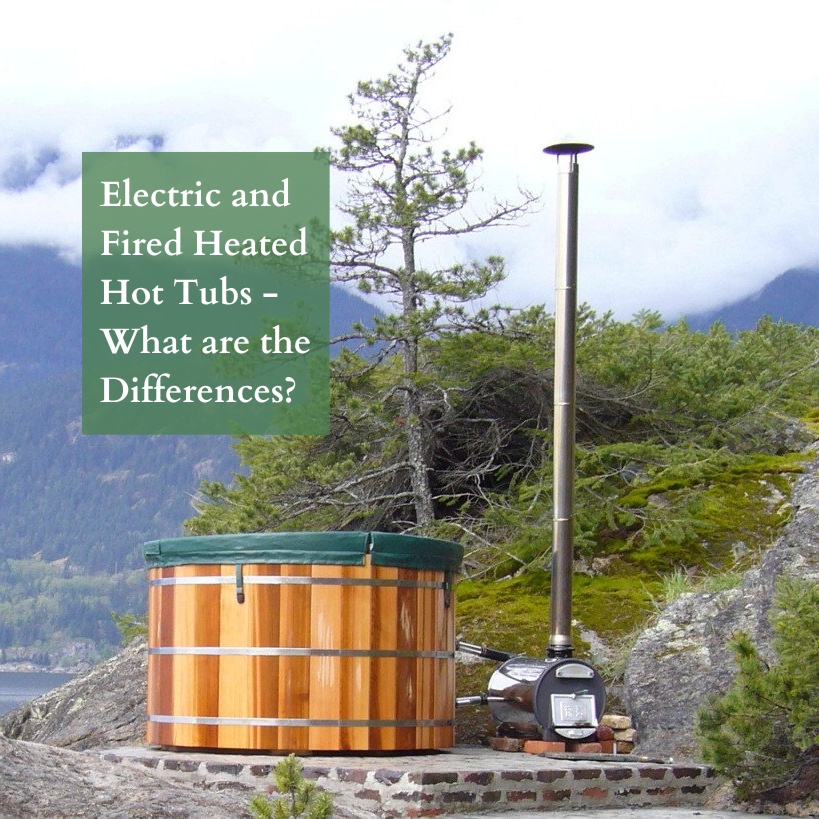What are the differences between wood heated and Electric Hot Tubs?
Electric heaters and wood-burning heaters are the two most widely used methods of heating hot tubs. Depending on your preferences, location and house design, one may make more sense than the other. Both have pros and cons that you should consider. Overall, wood-fired hot tubs require less maintenance, last longer and heats up faster. Electric heaters can, however, also be useful and affordable depending on the situation.
Whether you’re planning to build a new house or are investing money to renovate your current home, a hot tub or spa in your backyard will create a special relaxing ambiance. Despite the fact that both types of hot tubs have the potential to promote at-home relaxation, how are they different from one another? For your consideration, the key differences between the two are noted below.
How long does a fired heated vs electric hot tub take to warm up?
Unlike wood-fired hot tubs, which are heated by burning wood, electric heaters heat spas using electricity. Although each complete the same work, there are significant differences between them. Despite the fact that the heating time for all hot tubs varies on a few factors, including the water’s initial temperature, how cold it is outside, and the amount of water in your tub, wood-fired hot tubs heat up substantially quicker than spas powered by electricity. A stainless lined wood-fired hot tub typically takes 2.5 hours to heat up from cold to a 100 degrees, compared to up to 15 hours for a regular electric hot tub of the same size. In this case, a wood-fired tub is without a doubt the winner. Most of the time with electric hot tubs you never let them go completely cold if you intend them to use it again in the near future. This of course makes a huge difference in the cost of operating the hot tub. A befit of the electric is that once they are Electric hot tubs can take a little bit longer to warm up than fire heated hot tubs, but once they are ready, they will stay at your desired temperature. Whereas with fire heated hot tubs you need to maintain the fire in order to keep the water warm.

What is the cost of operating a fire headed hot tub vs electric?
Given that wood-fired bathtubs heats more than five times as fast, it makes sense to consider how much it would cost to make electric bathtubs five times as efficient. Wood-fired tubs only need dry firewood to work; no cords or power are needed. Since electric tubs require energy to function, how frequently you use your spa and the cost of utilities in your location will affect your maintenance expenditures. Our calculations revealed that using a tub everyday would cost less than $1.80, although real expenses would vary depending on the cost of firewood in your location. For the electric heated hot tub the cost will vary greatly on depending on how long and how hot you want the tub, along with the cost of the local electricity.
Where can you install a fire heated or electric hot tub?
There is nothing more soothing than taking a twilight soak in your outdoor wood-fired hot tub while stargazing. Hot tubs are a beautiful addition to decks and back yards. Installing your hot tub indoors is a terrific option if that’s what you like. However, electric-powered spas are constrained by the presence of power sources. A wood-fired tub can be placed anywhere as long as the ground is firm enough to hold it.
How often must a fire heated vs electric hot tub be serviced and cleaned?
You probably already know that chemicals are routinely used to disinfect the water if you’ve ever used a hot tub or jacuzzi. To retain the pH balance of the water and keep it clean for you to sit in, it takes labor to ensure that these chemicals are employed in the proper amounts. Additionally, when you drain your spa for routine cleaning, the chemicals in the water are added to the drainage system, which can be harmful to the environment. A Stoked wood-fired hot tub’s interior is constructed of the finest stainless steel. They need frequent draining and cleaning, just like an electric hot tub, but no chemicals are required for their upkeep, operation, or cleaning. The substance is designed to resist impurities like mold, algae, and others. Use fresh water just like you would for a bath, and when you need to drain it, you may reuse the water for cleaning, irrigation, or any other requirement for reused water. Stainless steel is the cleanest material that may be utilized for a hot tub.

What material are electric and fire heated hot tubes made from?
Typical conventional hot tubs are composed primarily of plastic and are built of fiberglass or acrylic plastic. Because they are frequently exposed to hot water and maintenance chemicals, these materials will deteriorate with time. A hot tub typically lasts five to ten years. The interior and internal components of each Stoked Stainless hot tub are made of reliable stainless steel. The metal is resistant to wear, abrasion, and corrosion and never rusts, fractures, or stains. The outside of your hot tub is exquisitely built from 100% natural cedar and strong enough to endure the weather if you choose to place it outside. The solid, high-quality construction of Stoked wood-fired hot tubs ensures their durability.
Today’s hot tubs have evolved from simple vinyl jacuzzis you place on your deck into sophisticated, eco-friendly, and long-lasting works of art. Get in contact with us to find out more about acquiring your very own wood-fired hot tub right away.
How long will electric vs fire heated hot tubs last?
Depending on how frequently they are used, both electric and fire-heated hot tubs have a lifespan. It will depend on a number of variables, including the hot tub’s size and construction, how frequently you use it, and your region’s climate. An electric hot tub normally lasts 10 years on average, whereas a hot tub heated by fire typically lasts 20 to 25 years.
What takes longer to warm up electric or fire heated hot tub?
Hot tubs heated by electricity often take longer to heat up than hot tubs heated by fire.
This is because a fire may start right away and give more rapid warmth, whereas electric heating systems take longer to warm up.
